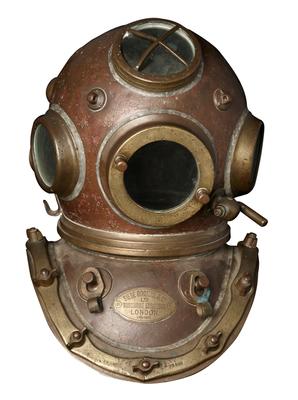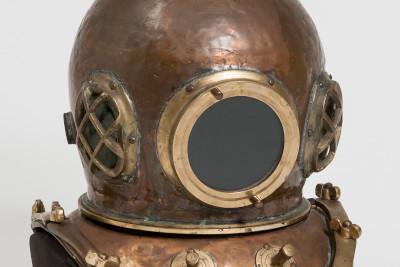Diving Helmet
Production date
1940-1949
See full details
Object detail
Description
Siebe Gorman Diving Helmet, c.1940s
Standard Diving Dress Helmet, 12 bolt, 4 light (window).
Part 1: helmet
Part 2: metal hinge
Part 3: metal hinge
Standard Diving Dress Helmet, 12 bolt, 4 light (window).
Part 1: helmet
Part 2: metal hinge
Part 3: metal hinge
Classification
MARITIME TECHNOLOGY Diving Diver's helmet
Maker
Production date
1940-1949
Production place
Measurements
H510mm x W360mm x D420mm
Media/Materials description
Copper, brass, lead solder, glass
Signature/Marks
Manufacturer's name plaque (centre front of corselet):
SIEBE GORMAN & CO.
LTD
SUBMARINE ENGINEERS
LONDON
PATENT
SIEBE GORMAN & CO.
LTD
SUBMARINE ENGINEERS
LONDON
PATENT
History and use
The 12 bolt Siebe Gorman helmet was popular with construction and salvage divers in Australia up until the 1950s. This helmet had 4 lights (windows), the fourth light at the top of the helmet allowed the diver increased vision, particularly when ascending.
This helmet was possibly owned and used by Merv Morely, a diver who was involved in the construction o the Hobart Bridge in the early 1960s.
Siebe Gorman Ltd is a British company, which developed diving equipment and breathing equipment, and worked on commercial diving and marine salvage projects. The company advertised itself as 'Submarine Engineers' and was founded by Augustus Siebe and his son-in-law, Gorman. The company was particularly notable for developing the 'closed' diving helmet of the standard diving dress and associated equipment. As the helmet was sealed to the diving suit, it was watertight, unlike previous 'open' helmet systems. The new equipment was safer, more efficient and revolutionised underwater work from the 1830s.
Siebe Gorman manufactured the 12 bolt helmet continuously from 1837 to 1975. It takes its name from the number of bolts, which project from the breastplate or corselet piece. The rubber and canvas diving suit would be tightly clamped in place on these bolts, making a watertight seal. The top of the helmet could then be screwed in place and the diver allowed to descend.
This 12 bolt 'closed' diving system was copied by many manufacturer's from around the world, including Korea, Japan, China and Italy. Versions of it are still produced in some countries today. Its simplicity and robust reliability meant that divers could be quickly and easily trained in its use, and for many years it wast eh workhorse of the diving world.
This helmet was possibly owned and used by Merv Morely, a diver who was involved in the construction o the Hobart Bridge in the early 1960s.
Siebe Gorman Ltd is a British company, which developed diving equipment and breathing equipment, and worked on commercial diving and marine salvage projects. The company advertised itself as 'Submarine Engineers' and was founded by Augustus Siebe and his son-in-law, Gorman. The company was particularly notable for developing the 'closed' diving helmet of the standard diving dress and associated equipment. As the helmet was sealed to the diving suit, it was watertight, unlike previous 'open' helmet systems. The new equipment was safer, more efficient and revolutionised underwater work from the 1830s.
Siebe Gorman manufactured the 12 bolt helmet continuously from 1837 to 1975. It takes its name from the number of bolts, which project from the breastplate or corselet piece. The rubber and canvas diving suit would be tightly clamped in place on these bolts, making a watertight seal. The top of the helmet could then be screwed in place and the diver allowed to descend.
This 12 bolt 'closed' diving system was copied by many manufacturer's from around the world, including Korea, Japan, China and Italy. Versions of it are still produced in some countries today. Its simplicity and robust reliability meant that divers could be quickly and easily trained in its use, and for many years it wast eh workhorse of the diving world.
Associated person
Registration number
H3884




